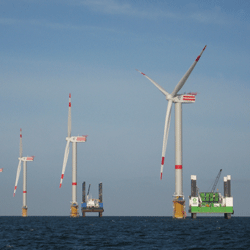 The federal government will offer $50.5 million in funding for research and development for offshore wind development over the next five years and will also identify potential sites on the Outer Continental Shelf (OCS) off of Delaware, Maryland, New Jersey and Virginia. These so-called Wind Energy Areas (WEAs) will receive expedited environmental reviews off the coasts, which could result in leases by the end of this year.
The federal government will offer $50.5 million in funding for research and development for offshore wind development over the next five years and will also identify potential sites on the Outer Continental Shelf (OCS) off of Delaware, Maryland, New Jersey and Virginia. These so-called Wind Energy Areas (WEAs) will receive expedited environmental reviews off the coasts, which could result in leases by the end of this year.
The joint announcement by the U.S. Department of the Interior (DOI) and the U.S. Department of Energy (DOE) comes on the heels of the federal government's quest to speed renewable energy development offshore by improving coordination with state, local and federal partners.
‘These investments will allow our country to compete in the clean energy and technology innovation race that is now being led by European countries and China,’ Jim Lanard, president of the Offshore Wind Development Coalition, tells NAW. He adds that the intergovernmental coordination is key for success.
The Mid-Atlantic WEAs are a key part of the DOE's Smart from the Start program for expediting appropriate commercial-scale wind energy development in U.S. waters.
According to the DOI and DOE, the funding initiative is the first-ever interagency plan on offshore wind energy. The plan focuses on overcoming three key challenges: the relatively high cost of offshore wind energy; technical challenges surrounding installation, operations and grid interconnection; and the lack of site data and experience with project-permitting processes.
According to Lanard, each utility-scale offshore wind farm range from $1.5 billion to more than $4 billion, depending on the number of turbines that would be installed.
‘Having those turbines and the associated supply-chain products made here will create highly skilled jobs for U.S. workers and will attract billions of dollars of investment to manufacture products for offshore wind,’ he says.
The three solicitations – which would amount to $50.5 million over five years – will help develop breakthrough offshore wind energy technology and reduce market barriers related to deployment, according to Energy Secretary Steven Chu.
Technology development, with funding of up to $25 million over five years, will support the development of innovative wind turbine design tools and hardware to provide the foundation for a cost-competitive offshore wind industry in the U.S. Specific activities will include the development of open-source computational tools, system-optimized offshore wind plant concept studies, and coupled turbine rotor and control systems to optimize next-generation offshore wind systems.
Funding of up to $18 million over three years will support baseline studies and targeted environmental research to characterize key industry sectors and factors limiting the deployment of offshore wind. Specific activities will include offshore wind market and economic analysis; environmental risk reduction; manufacturing and supply-chain development; transmission planning and interconnection strategies; optimized infrastructure and operations; and wind resource characterization.
Funding of up to $7.5 million over three years will be included for next-generation drivetrain development and refinement.
The areas on the OCS near Delaware (122 square nautical miles), Maryland (207 square nautical miles), New Jersey (417 square nautical miles), and Virginia (165 square nautical miles), will receive early environmental reviews that will help to reduce the time required for review, leasing and approval of offshore wind turbine facilities.
In March, the DOI expects to identify WEAs off of North Atlantic states, including Massachusetts and Rhode Island, and will launch additional National Environmental Policy Act (NEPA) environmental reviews for those areas. A similar process will occur for South Atlantic states, namely North Carolina, this spring.
The DOE and DOI say that if no significant impacts are identified, BOEMRE could offer leases in these Mid-Atlantic areas as early as the end of this year, or early 2012. Comprehensive site-specific NEPA review will still need to be conducted for the construction of any individual wind power facility, and BOEMRE will work directly with project managers to ensure that those reviews take place on aggressive schedules.
‘This $50 million funding commitment is welcome news and is a shot in the arm for the offshore wind industry,’ says Lanard. ‘The U.S. has been lagging behind in the technology race regarding development of products for the offshore wind industry, and the government is now making the commitment to catch up and get ahead.’



